
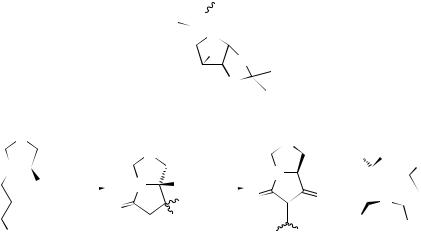
1 Reactions of Aldehydes and Ketones and their Derivatives |
|
|
|
11 |
|||||||||||
|
|
|
|
|
|
|
OSiMe2But |
|
|
|
|
|
|
|
|
|
|
|
|
Me3SiO |
O |
|
|
|
|
|
|
|
|||
|
|
|
|
|
|
|
|
|
|
|
|
|
|||
|
|
|
|
|
|
BnO |
|
|
|
|
|
|
|
||
|
|
|
|
|
|
|
|
O |
|
|
|
|
|
|
|
|
|
|
|
|
|
|
O |
|
|
|
|
|
|
|
|
|
|
|
|
|
|
(38) |
|
|
|
|
|
|
|
|
|
|
|
S |
|
|
|
|
|
|
S |
PriO O− |
|
|
|||
|
|
|
|
|
S |
|
|
|
|
|
|||||
|
|
|
|
|
|
|
|
|
|
|
Me |
||||
|
|
N |
|
|
|
|
|
N |
|
|
|
|
|||
|
|
|
|
CO2Pri |
|
|
O |
|
|
|
|||||
O |
|
CO2Pri |
|
N |
|
|
|
|
|
||||||
|
|
|
|
|
|
|
|||||||||
|
|
|
O |
|
O |
|
|
|
|
|
|||||
|
|
|
|
O |
H |
|
|
|
|
N |
|
|
|||
O |
|
|
|
Me |
|
|
|
|
|
S |
|
|
|||
|
Me |
|
|
|
|
HO |
|
Me |
O |
||||||
|
|
|
|
|
|
||||||||||
|
|
|
|
|
|
||||||||||
|
|
|
|
|
|
|
|
|
|
|
|||||
|
|
|
|
|
|
|
|
|
|
|
|
|
|||
|
|
|
|
|
|
|
|
|
|
|
|
|
|
|
|
|
(39) |
|
(40a,b) |
|
|
|
(41) |
(42) |
|
|
|||||
Silyl enol ether (38), derived from D-glucose, undergoes a useful one-carbon extension by way of an asymmetric aldol reaction;48 the conditions of the indium(III) catalysis in water are very convenient.
A stereoselective intramolecular aldol reaction of thiazolidinecarboxylate (39) proceeds with retention of configuration to give fused heterocycles (40a,b; separable) and (41), the product of a retroaldol–acylation reaction.49a The selectivity is suggested to be directed by ‘self-induced’ axial chirality, in which the enolate generated in the reaction has a stereochemical ‘memory,’ being generated in an axially chiral form (42).49b The retroaldol step also exemplifies a stereoretentive protonation of an enolate.
The lithium enolate of di-t -butyl malonate undergoes a stereoselective aldol reaction with α-alkoxyaldehydes to give anti-1,2-diol derivatives;50 in the case of the highly hindered 2-trityloxypropanal, the stereochemistry is reversed.
A series of trans-chelating chiral biferrocene diphosphine ligands enable a rhodium(I)-catalysed aldol reaction of 2-cyanopropionates to proceed in up to 93% ee.51
Asymmetric aldol additions of trichlorosilyl enolates of cyclic ketones to aldehydes have been studied, with a particular focus on the electronic effect of the aldehyde on the selectivity achieved.52
A review of enantioselective aldol additions of latent enolate equivalents covers a variety of SnII, boron, TiIV, CuII, lanthanide, and Lewis base catalysts.53 Asymmetric aldol reactions using boron enolates have been reviewed (401 references).54
Mukaiyama and Other Aldol-type Reactions
In the Mukaiyama cross-aldol reaction, an aldehyde and a ketene silyl acetal [e.g. (43)] react via Lewis acid catalysis to give a β-silyloxy ester (44). The reaction
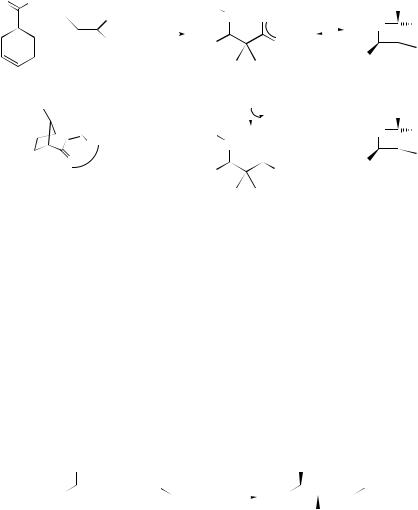
12 |
Organic Reaction Mechanisms 1998 |
is assumed to involve an intermediate cation (45), set up for intramolecular silicon transfer. However, in some cases the trimethylsilyl group can be captured by the carbonyl substrate, leading to catalysis by Me3Si+, i.e. an achiral route.55a,b It has now been shown that the 2+2-addition intermediates, (46) and (47), form reversibly in the presence of a chiral europium catalyst, equilibrating over 2 h at 20 ◦C in benzene.55c While considerably complicating the mechanistic scheme, their formation minimizes that of Me3Si+. The influence of the relative rates of the steps involved on the ee outcome is discussed with respect to the design of effective asymmetric catalysts.
O |
H |
|
|
|
Eu |
|
|
|
|
|
|
|
|
|
|
OSiMe3 |
||
|
|
|
|
OSiMe3 |
|
|
|
|
|
|||||||||
|
|
|
OSiMe3 |
|
|
|
|
|
|
|
|
|
||||||
|
+ |
|
|
|
|
O |
|
|
|
|
O |
OMe |
||||||
|
|
OSiMe3 |
Eu |
|
+ |
|
|
|
|
|
||||||||
|
|
|||||||||||||||||
|
|
|
|
|
||||||||||||||
|
|
|
|
|
|
Ph |
|
|
|
OMe |
|
|
|
Ph |
|
|||
|
|
|
|
|
|
|
|
|
|
|
|
|
|
|||||
|
(43) |
|
|
|
|
(45) |
|
|
|
|
|
|
|
|
||||
|
|
|
|
|
|
|
|
|
|
(46) |
||||||||
|
|
|
|
|
|
|
|
|
|
|
|
|
||||||
|
|
|
|
|
|
|
|
|
|
|
|
|
|
|
|
|
|
+ |
|
|
C3F7 |
|
|
|
|
|
|
|
"Eu" |
|
|
|
OMe |
||||
"Eu" = |
|
|
Me3Si |
|
O |
|
|
O |
OSiMe3 |
|||||||||
|
|
|
|
|
|
|
||||||||||||
|
O |
|
|
|
|
|
|
|||||||||||
|
|
|
|
|
O |
|
|
|
|
|
||||||||
|
O 3 Eu |
|
|
|
Ph |
|
|
|
OMe |
|
|
Ph |
|
|||||
|
|
|
|
|
|
|
|
|
|
|||||||||
|
|
|
|
|
|
|
|
|
|
|
|
|
|
|||||
|
|
|
|
|
|
|
|
|
|
|
|
|
|
|
(47) |
|||
|
|
|
|
|
|
|
|
(44) |
|
|
|
|
|
|
|
|
|
|
A Mukaiyama-type aldol reaction of silyl ketene thioacetal (48) with an aldehyde with large and small α-substituents (e.g. Ph and Me), catalysed by boron trifluoride etherate, gives mainly the syn-isomer56 (49), i.e. Cram selectivity. For the example given, changing R from SiBut Me2 to Si(Pri )3 raises the syn preference considerably, which the authors refer to as the ‘triisopropylsilyl effect.’ Even when the RL and RS groups are as similar as ethyl and methyl, a syn:anti ratio of 5.4 was achieved using the triisopropylsilyl ketene thioacetal.
Samarium and other lanthanide iodides have been used to promote a range of Mukaiyama aldol and Michael reactions.57 The syntheses show promise as enantioselective transformations, but the precise mechanistic role of the lanthanide has yet to be elucidated.
|
RS |
|
|
|
|
RS |
||||
|
|
|
R3SiO |
|
|
S-But |
|
|
|
S-But |
RL |
|
|
+ |
|
|
|
|
RL |
|
|
|
|
|
|
|
|
|
||||
|
O |
|
|
|
|
OH O |
||||
|
|
|
|
|
||||||
|
|
|
|
(48) |
(49) |
|
|
|||
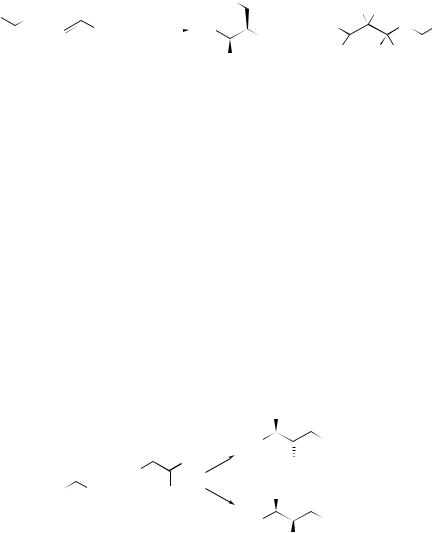
1 Reactions of Aldehydes and Ketones and their Derivatives |
13 |
A bulky methylaluminium diphenoxide has been used as a co-catalyst with trimethylsilyl triflate to effect diastereoselective Mukaiyama aldols, including cases with less reactive aldehydes, and with ketones.58
α-Phenylthiomethyl-β-hydroxy esters (50) can be prepared, predominantly as the syn-isomer, by a stereoselective one-pot Michael–aldol tandem reaction.59 The seleno analogue can similarly be prepared (again, mainly syn), using PhSeLi in diethyl ether, but phenoxide ion is not sufficiently reactive for this sequence.
|
|
|
|
|
|
PhS |
R2 |
R3 |
|
|
|
|
R2 |
|
|
H |
|
|
|
|
|
|
|
||
|
|
|
PhSLi |
HO |
O |
|
|
R |
1 |
|||
|
|
|
+ |
|
|
|
||||||
|
|
|
CO2R1 |
|
R2 |
|
|
|
||||
|
|
|
|
|
||||||||
|
|
|
|
|
CH2Cl2 |
CO2R1 |
|
|
|
|
|
|
|
O |
|
|
|
|
|
|
|||||
|
|
|
|
H1 R4 |
H1 R1 |
|
|
|
|
|||
|
|
|
OH |
O |
|
|||||||
|
|
|
|
|
|
|
|
|
|
|
|
|
|
|
|
|
|
(50) |
|
(51) |
|
|
|
|
|
In the aldol–Tishchenko reaction, a lithium enolate reacts with 2 mol of aldehyde, ultimately giving, via an intramolecular hydride transfer, a hydroxy ester (51) with up to three chiral centres (R1, H1 derived from R1CH1O). The kinetics of the reaction of the lithium enolate of p-(phenylsulfonyl)isobutyrophenone with benzaldehyde have been measured in THF.60 A kinetic isotope effect of kH/ kD = 2.0 was found, using benzaldehyde-d. The results and proposed mechanism, with hydride transfer rate limiting, are supported by ab initio MO calculations.
Complete control of the diastereoselectivity of the synthesis of 1,3-diols has been achieved by reagent selection in a one-pot tandem aldol–reduction sequence (see Scheme 1).61 Anti-selective method (a) employs titanium(IV) chloride at 5 ◦C, followed by Ti(OPri )4, whereas method (b), using the tetrachloride with a base at −78 ◦C followed by lithium aluminium hydride, reverses the selectivity. A non-polar solvent is required (e.g. toluene or dichloromethane, not diethyl ether or THF), and at the lower temperature the titanium alkoxide cannot bring about the reduction of the aldol. Tertiary alkoxides also fail, indicating a similarity with the mechanism of Meerwein–Ponndorf reduction.
OH
R1 |
|
OH (anti) |
|
|
O |
O |
(a) |
R2 |
||||
|
|
|||||||
R1 |
|
|
|
|
+ |
R2 |
|
OH |
|
|
|
||||||
|
|
|
|
H |
H |
(b) |
||
|
|
|
|
|
|
|
|
|
R1 |
OH (syn) |
R2
SCHEME 1
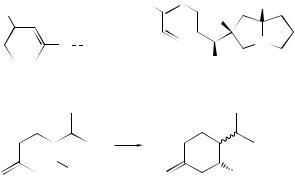
14 |
Organic Reaction Mechanisms 1998 |
As part of a search for environmentally friendly solid acid–base catalysts, a modified Mg–Al hydrotalcite has been used as a base catalyst for aldol and Knoevenagel condensations.62 Yields are often quantitative, reaction times are about 1h, the catalyst can be recovered by filtration, and only moderate temperatures are required (60 ◦C for the aldol, ambient for the Knoevenagel).
Chiral bicyclic 1,2,4-triazolium salts, in which a defined face of the heterocycle is hindered, catalyse the benzoin condensation with up to 80% ee, and with the opposite chirality to the corresponding thiazole catalysts.63 Conformationally restricted chiral bicyclic thiazolium salts have been similarly investigated.64
The Baylis–Hillman coupling of activated alkenes with aldehydes or ketones is a useful synthetic route, but can be very slow, even with catalysts from Group 15 (amines, phosphines), or, more recently, lanthanides. A chalcogen variant has now been reported,65 in which 0.1 equiv. of catalyst gives high yields in 1 h at room temperature, using the condensation of p-nitrobenzaldehyde and cyclohex-2-enone as reference reaction. Most of the chalcogenides used were cyclic structures involving two heteroatoms (S/Se/N), but even dimethyl sulfide is effective in some cases. Several common Lewis acids were employed as co-catalysts, of which TiCl4 at a level of 1 equiv. proved best. The mechanism is proposed to involve coordination of titanium at the enone oxygen, followed by, e.g., sulfide attack at the β-vinyl position to give a zwitterionic enolate (52), which then reacts with the aldehyde.
Me |
S+ |
O2N |
|
H |
|
|
H |
||
2 |
|
|
|
|
|
|
O− TiCl4 |
|
N |
|
|
|
||
|
|
|
|
OH |
|
|
(52) |
(53) |
|
O |
OH |
(54) |
(55) |
A chiral pyrrolizidine (53) catalyses asymmetric Baylis–Hillman reactions.66 Important structural features include an accessible nitrogen lone pair and a strategically placed hydroxy group; the latter may also interact with alkali metal cations, which catalyse the reaction.
Enal (54) undergoes intramolecular carbonyl–ene cyclization to give cis- and trans- alcohols (55).67a Lewis acids such as boron trichloride and tin tetrachloride (and also dimethylaluminium chloride67b) give predominantly the cis product, while the preference is reversed with the bulky MeAlAr2(Ar = OC6H2-4-Br-2, 6-di-But ). ‘Open’ and ‘closed’ chair-like transition states are considered and compared with previous
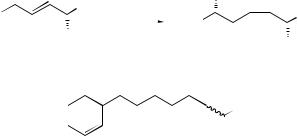
1 Reactions of Aldehydes and Ketones and their Derivatives |
15 |
mechanistic models, but it is suggested that a boat-like state is required to explain the formation of trans-(55).
Activated enophiles such as aldehydes and keto diesters undergo ene reactions to give homoallylic alcohols:68 a ruthenium(II) complex is employed as catalyst in an apparently stepwise process.
The Horner–Wadsworth–Emmons reaction has been explored by quantum-mecha- nical calculations on the formaldehyde–trimethylphosphonacetate [O=P(OMe)2−
−
CH−CO2Me] model system.69 The reactants form an oxyanion, which can then ring close to an oxaphosphetane. The latter step was found to be rate determining in the gas phase, but solvation typically changes the course of the reaction significantly, making oxyanion formation rate limiting.
An asymmetric Horner–Wadsworth–Emmons reaction has been developed which uses an external chiral ligand to avoid the need to prepare chiral phosphonate derivatives.70
Allylations
A theoretical study of allylboration of aldehydes shows that (i) an initial complex may form, but if so, it is weak, and predicted reactivity trends are unchanged whether it is taken into account or not, and (ii) electron delocalization from the aldehyde oxygen to the boron p atomic orbital governs the reaction.71
Tin(IV) halide-catalysed reactions of 4-, 5-, and 6-alkoxy(alk-2-enyl)stannanes exhibit 1,5-, 1,6-, and 1,7-asymmetric induction, respectively.72a For example, 4-substituted (pent-2-enyl)stannanes (56) give ε-hydroxy derivatives (57) with a syn:anti ratio of >30 for hydroxy and benzyloxy substrates (i.e. R2 = OH, OCH2Ph). A key allyltin trichloride intermediate has now been identified, and the transition states for its reaction with aldehyde have been calculated as being over 10 kcal mol−1 apart for the alternative product stereochemistries.72b
Intramolecular cyclization of tethered phenyl ketones (58; X = Br, SiMe3) show contrasting stereochemical outcomes for indium catalysis of the alkyl bromides and fluoride ion-induced reaction of the allylsilanes.73 The reactions thus allow complementarity in product diastereoselectivity, and the difference appears to be related to an
|
|
Me |
|
|
|
OH |
||||||
(R1)3Sn |
|
|
|
SnCl4 |
|
|
|
|
|
|
Me |
|
|
|
|
|
|
|
|
|
|
|
|||
|
|
R3 |
||||||||||
|
||||||||||||
OR2 |
|
|
R3CHO |
|
|
|||||||
|
|
|
||||||||||
|
|
|
|
|
|
OR2 |
||||||
(56) |
|
|
|
|
|
(57) |
||||||
|
|
|
|
|
|
|
|
|||||
|
|
|
O |
|
|
|
|
|
|
|
||
|
|
|
|
|
|
|
|
X |
||||
|
|
|
|
|
|
|
|
|||||
|
|
|
|
|
|
|
|
|||||
|
|
|
|
|
|
|
|
|
|
|
|
|
(58)

16 |
Organic Reaction Mechanisms 1998 |
intramolecular cyclic transition state in the former, versus an open-chain antiperiplanar one in the latter.
Chiral alkoxyand aminomethyl-substituted α-allylsilyl carbanions have been reacted with aldehydes to give 1-silylhomoallylic alcohols with high γ -regioselection and E-stereoselection, and moderate to good de.74
(E)- or (Z)-γ -alkoxyallylstannanes, Bu3SnCH2CH=CHOR, undergo a lightpromoted reaction with various classes of carbonyl compounds (aldehydes, ketones, α-diketones) to give homoallylic alcohols with retention of double-bond geometry.75 A series of single electron transfers are proposed to account for the transformation.
A norpseudoephedrine auxiliary has been used to achieve >98% ee in the preparation of homoallylic alcohols from aliphatic alcohols and allylsilane.76 On-line NMR spectroscopy has been used to shed light on the mechanism, including a diversion that occurs if the temperature is not kept low enough.
An allylzinc addition is described under Addition of Organometallics below.
Other Addition Reactions
General and Theoretical
The intrinsic basicities of cyclopentenone and cyclohexenone (59), and their lactone analogues (60), have been accessed via measurement of their gas-phase proton affinities, and compared with the saturated carbonyl compounds in both cases.77 The results indicate that:
(i)basicities are greater for the larger rings;
(ii)unsaturated lactones are more basic than their acyclic analogues; and
(iii)cyclic ketones are made more basic by α,β-unsaturation, whereas ketones are not.
Ab initio calculations identify the sources of these effects: for example, in unsaturated ketones the double bond participates fully in the change in charge distribution accompanying protonation, while in the unsaturated lactones, the ring oxygen impedes this shift of electron density.
The hydrogen-bond basicities of a very extensive range of aldehydes and ketones have been measured, and are reported in terms of Taft’s pKHB scale.78
Ab initio calculations on the interaction of HF with a wide variety of carbonyl types show correlations between the energy of hydrogen-bond formation and both the H−F
O O
O
 ()n
()n  ()n
()n
(59) (60) n = 1, 2

1 Reactions of Aldehydes and Ketones and their Derivatives |
17 |
infrared stretching frequency and bond length.79 However, a correlation of this energy with the atomic charge on the carbonyl oxygen in the isolated molecules failed, but the molecular electrostatic potential at the oxygen does show a linear relationship over the whole series studied.
Several theoretical and experimental approaches to understanding π -facial selectivities of nucleophilic additions have been described. The factors affecting selection in addition of nucleophiles to cyclohexanone and its thione analogue have been probed via ab initio calculations.80 A wide range of nucleophile basicities have been included, while minimizing structural change, by using substituted acetylide and cyanide ions. As the nucleophile approaches, the carbonyl carbon becomes more electron deficient, with polarization in the π -bond not being compensated until very late in the addition. Examining the relative stabilities of the axial and equatorial transition states, the relationship to nucleophile basicity is found to be parabolic: the axial preference is maximal for moderately basic anions, and is diminished (or reversed) for the most and least basic. Hence the axial preference coincides with the maximum electron deficiency at the reaction site, and is reduced for reactions proceeding through very early or late transition states. Thus the axial approach appears to result from stabilization of the electron-deficient carbonyl carbon by σC−H hyperconjugation. This is further borne out by the greater axial preference in the case of the ketone versus the thione, consistent with the greater electron deficiency in the former.
When a nucleophilic reagent, Nu−X+ (or Nu−X), is reacted with a ketone, complexation of oxygen by X+ may precede attack at carbon. Geometric changes associated with such complexation have been calculated for a series of 4-substituted cyclohexanones.81 The results allow the facial selectivity of the subsequent nucleophilic attack to be predicted, and without the need to calculate the transition-state geometry.
4-Substituted snoutan-9-ones (61a) undergo nucleophilic additions with the same facial selectivity as the corresponding norsnoutanones (61b).82a However, the selectivity is markedly reduced, apparently owing to electrostatic effects in (61a), and hyperconjugative interactions in (61b).82b
The effect of remote halo substitution on the face selectivity of addition to 5-haloadamantan-2-ones (62b) has been extended to the corresponding norand homoadamantane systems, (62a) and (62c), and to some of their aza and diaza analogues.83 A syn approach of the nucleophile is favoured in all cases.
O |
O |
O |
|
|
|
|
|
|
|
|
|
|
|
|
|
|
|
|
|
S O |
|
|
|
|
|
|
S |
||||
|
|
|
|
|
|
|
|
|
|
||||||
|
|
|
|
|
|
Me |
|
|
|
|
|
|
|||
|
|
|
|
|
|
|
|
|
|
|
|
|
|||
|
|
|
|
|
|
|
|
H |
|
|
O |
|
|
|
O |
|
|
()n X |
|
|
|
|
|
|
|
|
|
Me |
|||
|
|
|
|
|
|
|
|
|
|
|
|
||||
|
|
|
|
|
|
|
(63) |
|
H |
||||||
|
|
|
|
|
|
|
|||||||||
(61a) |
(61b) |
(62a,b,c) |
|
|
|
|
|
|
|
|
|
||||
|
|
O |
|
|
|
|
|
|
|
||||||
|
|
|
|
|
|
|
|
|
|
|
|
|
|||
a: n = 0 b: n = 1 c: n = 2
18 |
Organic Reaction Mechanisms 1998 |
The diastereoselectivity of nucleophilic addition to 6-methyl-1-oxa-4-thia- spiro[4.5]dec-6-ene-7-carbaldehyde (63) has been explored for a variety of sp3-, sp2-, and sp-nucleophiles.84a In addition to having a strategically placed heteroatom, the position is also vinylogous. A range of selectivities was observed, from modest preference anti to sulfur, to a strong preference for syn in the case of phenylmagnesium bromide. The selectivities, which were sensitive to solvent polarity, were not explicable in terms of Wipf’s dipole model.84b,c The syn selectivities observed for the sp2/sp-nucleophiles investigated are speculated to arise from specific electrostatic attractions for S for such nucleophiles with their negative charges concentrated on carbon.
Hydration and Related Reactions
Calculations support a cooperative mechanism for the hydration of formaldehyde, acetaldehyde, acetone, and cyclohexanone in water.85 The results are supported by determination of the rate constant for the neutral hydration of acetone, using labelled acetone and water. Conclusions include:
(i)four non-spectator water molecules are involved in neutral hydration;
(ii)acetaldehyde is hydrated syn to hydrogen; and
(iii)equatorial hydration of cyclohexanone is >100 times faster than axial hydration.
Gas-phase acid-catalysed additions of water and methanol to ethanol and its α-halo derivatives have been investigated by computation; both reactions are favoured by increasing the electronegativity of the halogen.86
The energy barrier for the gas-phase addition of ammonia to formaldehyde has been calculated,87 and a molecular dynamics study of its hydration in aqueous sulphuric acid is reported.88
For hydration of an α-aminotetrahydropyranone, and the hydrate and hydrate anion of α,α,α-trifluoroacetophenone, see under Acetals and Aldols above, respectively.
Addition of Organometallics
Several stereoselective dialkylzinc additions have been reported. The oxazolidine catalyst series (64) gives moderate ees in the addition of diethylzinc to benzaldehyde.89 Substituent effects on the mechanism of induction have been explored for a range of aliphatic and aromatic R groups, and two variants of Ar (o- and p-tolyl).
|
|
|
|
|
|
|
|
|
|
|
|
|
|
Chiral amines, ArCH(R)NH2, can be prepared by addition |
of a |
dialkylzinc to |
|||||||||||
N -(diphenylphosphinoyl)imines, ArCH N |
− |
P( |
= |
O)Ph |
|
, using a |
suitable |
auxiliary, |
|||||
followed by acid hydrolysis |
= |
|
|
|
2 |
|
90 |
A |
series of |
||||
to cleave |
|
the |
phosphorus |
moiety. |
|
||||||||
2-azanorbornylmethanols (65) |
give ees |
up to |
92%, |
and |
they |
also |
induce some |
||||||
enantioselectivity in additions to benzaldehyde. A highly organized transition state with two zincs is proposed: one coordinates the nitrogens of substrate and catalyst and the other coordinates the oxygens.
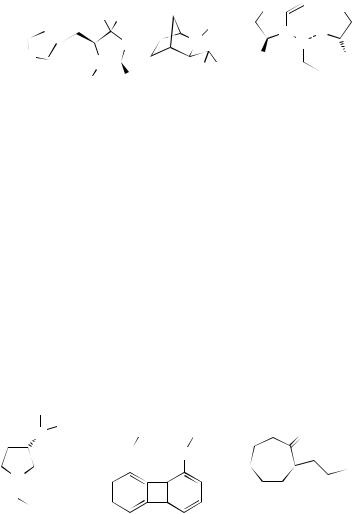
1 Reactions of Aldehydes and Ketones and their Derivatives |
|
19 |
||||||
|
Ar |
Ar |
|
O |
|
|
|
O |
|
|
R1 |
|
|
|
|
||
|
|
|
|
|
|
|
|
|
|
|
|
|
N |
N |
|||
|
|
O |
N |
OH |
||||
HN |
|
|
|
Zn |
||||
N |
|
|
Ph |
|
|
|
Ph |
|
|
|
R2 R2 |
|
|
|
|
||
|
Me |
R |
|
|
|
|
||
|
|
|
|
|
|
|
||
|
(64) |
|
(65) |
|
|
(66) |
|
|
|
|
|
|
|
|
|||
Other diethylzinc studies include enantioselective additions to benzaldehyde using aziridine alcohols as catalysts,91 to ketones using a camphorsulfonamide–titanium alkoxide catalyst,92 to aromatic aldehydes using (S)-valine-derived N,S-chelate ligands possessing a stereogenic nitrogen donor atom,93 and using a chiral o-hydroxyphenyldiazaphospholidine oxide catalyst.94
A diastereomeric allylzinc (66) has been used to allylate alkyl ethynyl ketones with >90% ee.95 The more substituted the alkyl group, the higher is the selectivity: adamantyl gives >99.9%. However, even PhCH2CH2COC≡CH reacts with >90% ee, indicating that (66) can recognize small differences between the groups flanking the carbonyl.
Among other enantioselective alkylations, a series of 3-aminopyrrolidine lithium amides (67; derived from 4-hydroxy-L-proline) have been used to induce high ees in the addition of alkyllithiums to various aldehydes.96 Structure–activity relationships are identified, and the role of a second chiral centre (in the R group) in determining the stereochemistry of the product is discussed.
Li |
|
|
Me |
|
||
N R |
Me2−Al |
|
AlMe2 |
O |
||
|
Li+ |
|
O |
|
O |
|
N |
|
|
|
|
Ph |
|
Ph |
|
|
|
|
||
|
|
|
|
|
||
|
|
|
|
|
||
(67) |
|
|
|
(68) |
|
(69) |
A template (68) containing two aluminium centres, one nucleophilic and the other electrophilic, accelerates nucleophilic alkylation of aldehydes.97
Alkylation of the enolates of cycloalkane-1,3-diones has been carried out for ring sizes 7–10, using various reagents and solvents.98 O-/C-Alkylation ratios are found to decrease generally with increasing ring size, an effect ascribed to greater steric strain in the conjugated enolate resonance contributor.
The concept of ‘memory of chirality’99a —in which the chirality of the starting material is preserved in a reactive intermediate for a limited time—is discussed with particular reference to the C-alkylation of enolates of chiral ketones.99b

20 |
Organic Reaction Mechanisms 1998 |
As part of a strategy of employing monosaccharides as a convenient source of chirality, organometallic additions to protected L-erythrulose derivatives have been carried out.100 Employing silyl, benzyl, trityl, and acetonide protecting groups, the diastereoselectivities obtained are discussed in terms of chelation to the α-and/or the β-oxygen, and are compared with results for similar aldehydes.
Several approaches to stereoselective Grignard reactions are described. Placement of an L-fucose or D-arabinose unit β or γ to an aldehyde has been used to achieve highly diastereoselective addition of Grignard reagents (and of allyltributyltin with added magnesium bromide), exploiting coordination of the sugar ring oxygen to magnesium.101
The mechanisms of addition of organomagnesium reagents to 2-hydroxypropanal (a model chiral α-alkoxycarbonyl compound) have been predicted for the gas phase by calculation.102 Thermodynamics, barrier heights, stereochemistry, intraversus inter-molecular routes, and stoichiometry (‘assisted’ intermolecular, using 2 equiv. of Grignard reagent) have all been investigated. A predictive model has been developed for the anti:syn product ratio in the addition of MeMgCl to such compounds, using quantum-mechanical calculations and a kinetic analysis.103
In an investigation of the stereoselectivity of nucleophilic addition to larger ring systems,104 ethyl-, vinyl-, and ethynyl-lithium and -Grignard reagents have been added to 2-(3 -phenylpropyl)cycloheptanone (69). In all cases, the predominant product is the cis-alcohol, and calculations have been used to identify the steric and torsional effects in the transition state that favour this stereochemistry.
Fluoroform (CHF3) efficiently trifluoromethylates aromatic aldehydes to the corresponding alcohols when deprotonated by potassium DMSylate in DMF.105 This is surprising, as species such as KCF3 have carbenoid character, and tend to be unstable. However, the reaction fails for solvents such as THF, and appears to depend on a highly specific role for DMF. It is proposed that ‘CF3−’ is trapped in situ by the solvent to form the gem-amino alcoholate (70), which acts as a stable, masked form of the anion, which then attacks the aldehyde, regenerating DMF.
K+ |
O− |
N |
|
|
H |
|
|
F3C |
NMe2 |
S |
SiMe3 |
|
(70) |
(71) |
|
Dondoni pioneered the use of 2-(trimethylsilyl)thiazole (71) as a formyl anion equivalent for the homologation of aldehydes.106a Extension of this reaction to ketones would be very useful, but has thus far been restricted to trifluoromethyl cases.106b However, it has now been widened to include several α, α -alkoxy ketones, as demonstrated in a new route to branched-chain monosaccharides.106c Aldehydes catalyse the reaction, although the scope is still limited: electrophilic aldehydes, such as 2-fluorobenzaldehyde, promote the addition of (71) to electrophilic ketones.
